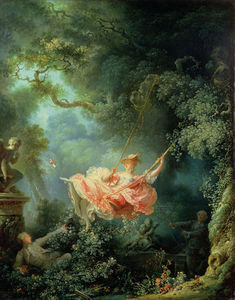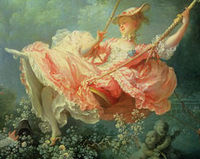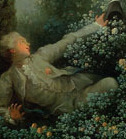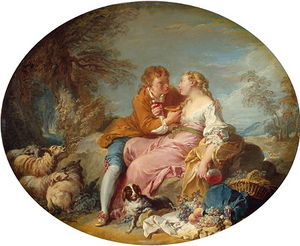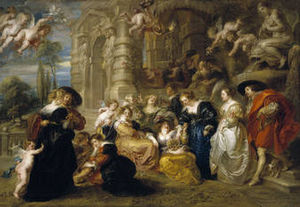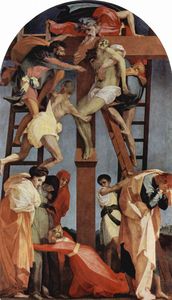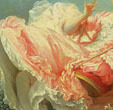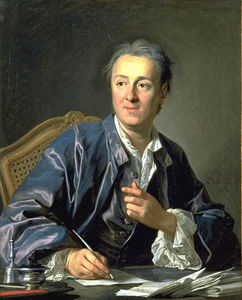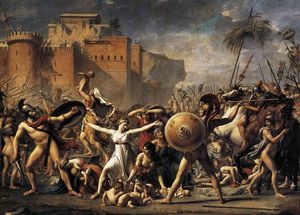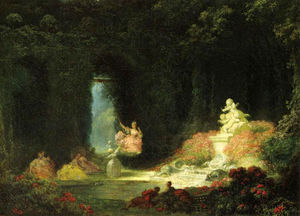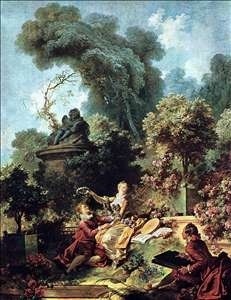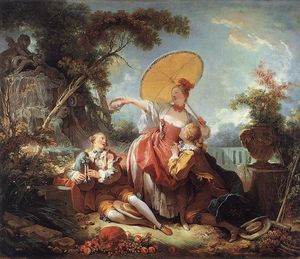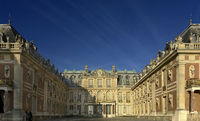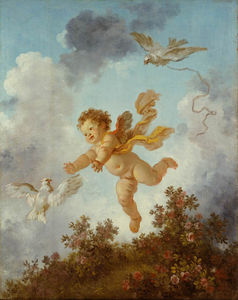The Swing
- Date of Creation:
- 1767
- Alternative Names:
- L'escarpolette
- Height (cm):
- 81.00
- Length (cm):
- 64.20
- Medium:
- Oil
- Support:
- Canvas
- Subject:
- Scenery
- Art Movement:
- Rococo
- Created by:
- Current Location:
- London, United Kingdom
- Displayed at:
- Wallace Collection
- Owner:
- Wallace Collection
The Swing Story / Theme
Commissioned by the notorious French libertine Baron de St. Julien as a portrait of his mistress, The Swing was to be painted to the following specificity: "I should like you to paint Madame seated on a swing being pushed by a Bishop. "
While this odd request was turned down by other painters such as Doyen, a painter of more serious historical subjects, Fragonard leapt to the occasion, producing what became the most iconic work of the French Rococo.
In the foreground the playboy Baron himself is depicted, reclining in the lush shrubbery, one arm outstretched towards the maiden's skirts, his other arm holding his balance. He gave very specific instructions to Fragonard, stating "Place me in a position where I can observe the legs of that charming girl. "
His mistress flies through the air on a sylvan swing, the lovely young lady giving herself away to frivolous abandon, her shoe flying off in the heat of the moment.
In the background of the composition one can see what was originally going to be the Bishop requested by the perverse Baron, but which was changed to the mistress's husband by Fragonard. The husband plays a lesser role, being immersed in shadow while the Baron is illuminated under the maiden's dress.
The inanimate objects add to the story as well. Two cherubs below the swing appear concerned by the sordid actions of the humans above them, one looking up at the women in trepidation and the other looking away from the action with a scowl. On the left side of the image is a stone statue of Cupid who raises a finger to his lips to point out the secretive nature of the impending affair.
Overall Fragonard's The Swing, rich with symbolism, not only manages to capture a moment of complete spontaneity and joie de vivre, but also alludes to the illicit affair that may have already been going on, or is about to begin.
The Swing Inspirations for the Work
Considered to be Fragonard's most successful painting, The Swing stands alone today as an emblem of Rococo art. The combination of insouciant attitude, tongue-in-cheek eroticism, pastel swirls, and pastoral scenery creates an irresistible testament to the beauty of youth and illegitimate affairs. In Fragonard's world, adultery is but a devilishly gay way to pass the time.
Francois Boucher:
One of Fragonard's first teachers, the art of Francois Boucher seems to have made an impression on the young painter, and can be seen in such erotic confections as The Swing.
Boucher specialized in the combination of the pastoral scene with a passionate sensibility. While originally commissioned to paint mythological scenes, Fragonard had a knack for turning them into more of a boudoir scene in open air and this cheeky sensibility is reflected in The Swing.
Peter Paul Rubens:
Always a fan of the Dutch Masters, the inspiration that Rubens provided is clear in this portrait with its attention to detail, loose fluid brushwork, and freewheeling attitude of the scene.
In addition, the Dutch of this time period were notorious for their inclusion of small symbolic items, which appear in The Swing in the case of the embracing putti and Cupid with his finger over his lips, to symbolize the secrecy of the affair. These are all reminiscent of earlier works by Rubens.
School of Fontainebleau:
The infamous French palace, decorated in the late 1500s by a group of painters headed by Rosso Fiorentino, specialized in eroticizing the mythological or classical subjects that were requested for the aristocrats of the time, serving as a precursor for the fanciful tastes that the later nobles would request.
Women at their bath, saucy portraiture, and pastoral settings were all seen here. The Swing would have fitted in perfectly.
The Swing Analysis
Fragonard painted The Swing with the intention of flattering the Baron and his mistress, to supply them with a lighthearted, frivolous painting and to provide an intimate memento of their relationship. To this end, he utilized only the finest of the Rococo techniques.
Composition:
The Swing is composed in a triangular shape, with the Baron and the husband forming the base of the pyramid, and the maiden in the air at the top of the triangle, in the center of the space.
She is illuminated by the soft lighting coming from above, and the fanciful trees form an oval frame for the action in the center.
Fragonard included a number of hidden details within the composition to heighten the message of playful love, including two putti embracing, a stone lap dog and dolphin, and a stone statue of Cupid.
The lady's slipper, which flies off her foot as she swings so easily, is another playful touch which helps accentuate the erotic subject matter, as well as providing a visual focus in the splash of sunlight.
Color Palette:
The Rococo style attempted to appeal more to the sensual rather than the intellectual side. As a result Fragonard utilized a delicate pastel color palette that would be just as at home in a cupcake shop as on canvas, with frothy creams, juicy pinks, and minty greens.
Lighting:
For this outdoor scene, Fragonard utilized a soft dappled sunlight filtering through the trees and backlighting them, infusing the scene with a soft, seductive glow. The light hits the young lady on the swing, highlighting her fair skin and the creamy billows of fabric that swirl around her.
In contrast, other aspects of the painting remain in shadow, such as the husband, possibly referencing his being "in the dark" as to his wife's affair.
Tone and Mood:
The mood in the painting is lighthearted and gay. The overall effect is one of erotic mirth and frivolity, typical of Rococo works. The contrast between light and shadow adds to the feeling that something illicit is taking place.
Brushstroke:
Emphasizing the free and easy nature of the subject matter, Fragonard uses a fluid, loose brushstroke, keeping the edges soft with regards to his main figures. In comparison to many of his other works however, he paints with a finer detail than usual, reminiscent of 17th Dutch masters such as Rembrandt.
The Swing Critical Reception
While during his lifetime The Swing was quite popular and Fragonard was at the top of his game, he fell out of favor after the Revolution. However modern day artists and designers have gained a new appreciation for the free-wheeling splendor of The Swing.
Contemporary Reception:
While Fragonard received no shortage of commissions from the aristocracy in Paris, the leading thinkers of the time had more unfavorable reactions to his work. Paintings such as The Swing brought Fragonard harsh criticism from philosophers such as Denis Diderot, one of the foremost designers of the French Enlightenment.
Posthumous Reception:
Post-revolution, there was no room for the frivolity and shallow subject matter of what was depicted in The Swing. A great deal of Fragonard's client base died during the Terror in Paris, and he was forgotten for a time.
The style and subject matter of The Swing was forsaken in favor of cleaner lines, moral severity, and classical subject matter of the Neoclassicists, such as Jacques-Louis David.
Modern Day Reception:
Currently, Fragonard's The Swing holds a dear place in the heart of pop culture and particularly high fashion, as it serves testament to the frivolity of the Rococo era, a period that the postmodern world attempts, at times, to emulate.
The Swing Related Paintings
The Swing Artist
Frothy and frivolous, The Swing not only served as a mirror of the pre-revolutionary era in Paris, but also stands as a time capsule of a brief time period of decadence and seduction.
As a landmark piece of the French Rococo, it can be defined by the masterly technique that Fragonard employed in its execution. Utilizing typical Rococo techniques such as billowing fabrics, pastel colors, and soft dappled lighting, he created a perfect confectionery painting, fit for the garden or the palace.
As charming and witty as his paintings, Jean-Honoré Fragonard was one of the most prolific artists of his time, producing more than 550 works during his career. Serving as an apprentice to Chardin and Boucher, two of the premier Rococo artists he later won the Prix de Rome and attended the French Academy.
Fragonard's work came with a high pedigree and prestige and as one of the last artists of the Rococo; his name is almost synonymous with this frivolous, erotic, and decadent movement.
Reputedly one of the most prolific painters of the 18th century, if not of all time, Fragonard had a feverish output of varied subject matter. From portraits to scenes of pastoral, erotic, or domestic appeal he covered a wide range of themes.
Fragonard's work is easily recognizable due to the lightness and frivolity of the subject matter, the deft touch of the brushwork, and the soft, carefree lighting schemes.
Today, Fragonard is thought of as a relic of a time past, a testament to a somewhat innocent time period before the French Revolution wiped out the aristocracy and ushered in a new era of democracy.
The Rococo has not weathered the test of time too well as far as being heralded as an artistic period that produced anything of importance. Rococo artists lived in their own bubble, much like the noble class of the day, and now their work is regarded more out of historical interest rather than artistic.
The Swing Art Period
Fragonard was a product of the later stages of the Rococo era, a time characterized by hedonistic freedom and a pursuit of all things aesthetically pleasing. The Rococo era originated from the French decorative style Racaille meaning 'decorative shell and rock work'.
Rococo was created by and for the rich of France. They wanted works that reinforced their wealth and pleasure in all beauty and splendor, as artists recreated scenes of arcadia. The Palace of Versailles was the ideal in decadent Rococo art and architecture, informed by ideas of the French Enlightenment.
A master of the domestic scene, the pastoral landscape and tongue-in-cheek eroticism of the boudoir painting, Fragonard had his share of admirers and wielded a strong influence over future masters of the art world, particularly the Impressionists.
Impressionism as a movement bears similarities to the Rococo in its emphasis on fleeting moments of beauty, sudden impressions, and pleasure.
Although for a time after the Revolution Fragonard disappeared from the history of art, his wittily airy style cropped up again years later with a new legion of imitators and by the end of the 19th century there was a rediscovery of Fragonard and other Rococo artists.
The Swing Bibliography
For further information about Jean-Honoré Fragonard's contribution to the Rococo movement, please choose from the following recommended sources.
• Ashton, D. Fragonard in the Universe of Painting. Prentice Hall & IBD, 1988
• Cuzin, Jean-Pierre. Fragonard: Life and Work. Harry N. Abrams, Inc. , 1988
• Dupuy-Vachey, Marie-Anne. Fragonard. Pierre Terrail, 2006
• Molotiu, Andrei. Fragonard's Allegories of Love. J Paul Getty Trust Publications, 2008
• Massengale, Jean Montague. Fragonard (Masters of Art). Harry N. Abrams, Inc. , 1998
• Rosenberg, Pierre. Fragonard: Metropolitan Museum of Art. Harry N. Abrams, Inc. , 1988
• Rosenberg, Pierre. From Drawing to Painting: Poussin, Watteau, Fragonard, David, and Ingres (A. W. Mellon Lectures in the Fine Arts). Princeton University Press, 2000
• Sheriff, Mary D. Fragonard: Art and Eroticism. University of Chicago Press; 2nd edition, 1990

